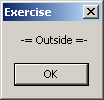|
|
A class can be created inside of another class. A class
created inside of another is referred to as nested. To nest a class, simply
create it as you would any other. Here is an example of a class called Inside
that is nested in a class called Outside:
|
Public Class Outside
Public Class Inside
End Class
End Class
In the same way, you can nest as many classes as you wish in
another class and you can nest as many classes inside of other nested classes if
you judge it necessary. Just as you would manage any other class so can you
exercise control on a nested class. For example, you can declare all necessary
fields, properties, or methods in the nested class or in the nesting class. When
you create one class inside of another, there is no special programmatic
relationship between both classes: just because a class is nested does not
mean that the nested class has immediate access to the members of the nesting
class. They are two different classes and they can be used separately as you
judge it necessary.
The name of a nested class is not "visible" outside of the
nesting class. To access a nested class outside of the nesting class, you must
qualify the name of the nested class anywhere you want to use it. For example,
if you want to declare an Inside variable somewhere in the program but outside
of Outside, you must qualify its name. Here is an example:
Public Module Exercise
Public Class Outside
Public Class Inside
Public Sub New()
MsgBox(" =- Inside -=")
End Sub
End Class
Public Sub New()
MsgBox(" -= Outside =-")
End Sub
End Class
Public Function Main() As Integer
Dim Out As Outside = New Outside
Dim Ins As Outside.Inside = New Outside.Inside
Return 0
End Function
End Module
This would produce:


Because there is no programmatically privileged relationship
between a nested class and its "container" class, if you want to access the
nested class in the nesting class, you can use its static members. In other
words, if you want, you can declare static all members of the nested class that
you want to access in the nesting class. Here is an example:
Public Module Exercise
Public Class Outside
Public Class Inside
Public Shared InMessage As String
Public Sub New()
MsgBox("=- Insider -=")
InMessage = "Sitting inside while it's raining"
End Sub
Public Shared Sub Show()
msgbox("Show me the wonderful world of C# Programming")
End Sub
End Class
Public Sub New()
MsgBox("-= Outside =-")
End Sub
Public Sub Display()
msgbox(Inside.InMessage)
Inside.Show()
End Sub
End Class
Public Function Main() As Integer
Dim Recto As Outside = New Outside
Dim Ins As Outside.Inside = New Outside.Inside
Recto.Display()
Return 0
End Function
End Module
In the same way, if you want to access the nesting class in
the nested class, you can go through the static members of the nesting class. To
do this, you can declare static all members of the nesting class that you want
to access in the nested class. Here is an example:
Public Module Exercise
Public Class Outside
Public Class Inside
Public Shared InMessage As String
Public Sub New()
MsgBox("=- Insider -=")
InMessage = "Sitting inside while it's raining"
End Sub
Public Shared Sub Show()
msgbox("Show me the wonderful world of C# Programming")
End Sub
Public Sub FieldFromOutside()
msgbox(Outside.OutMessage)
End Sub
End Class
Private Shared OutMessage As String
Public Sub New()
MsgBox(" -= The Parent =-")
OutMessage = "Standing outside! It's cold and raining!!"
End Sub
Public Sub Display()
MsgBox(Inside.InMessage)
Inside.Show()
End Sub
End Class
Public Function Main() As Integer
Dim Recto As Outside = New Outside
Dim Ins As Outside.Inside = New Outside.Inside
Recto.Display()
Ins.FieldFromOutside()
Return 0
End Function
End Module
This would produce:
Instead of static members, if you want to access members of
a nested class in the nesting class, you can first declare a variable of the
nested class in the nesting class. In the same way, if you want to access
members of a nesting class in the nested class, you can first declare a variable
of the nesting class in the nested class. Here is an example:
Public Module Exercise
Public Class Outside
REM A member of the nesting class
Private OutMessage As String
REM The nested class
Public Class Inside
REM A field in the nested class
Public InMessage As String
REM A constructor of the nested class
Public Sub New()
MsgBox("=- Insider -=")
Me.InMessage = "Sitting inside while it's raining"
End Sub
REM A method of the nested class
Public Sub Show()
REM Declare a variable to access the nesting class
Dim Outsider As Outside = New Outside
MsgBox(outsider.OutMessage)
End Sub
End Class REM End of the nested class
REM A constructor of the nesting class
Public Sub New()
Me.OutMessage = "Standing outside! It's cold and raining!!"
MsgBox("-= The Parent =-")
End Sub
REM A method of the nesting class
Public Sub Display()
MsgBox(insider.InMessage)
End Sub
REM Declare a variable to access the nested class
Dim insider As Inside = New Inside
End Class
Public Function Main() As Integer
Dim Recto As Outside = New Outside
Dim Ins As Outside.Inside = New Outside.Inside
Ins.Show()
Recto.Display()
Return 0
End Function
End Module
This would produce: